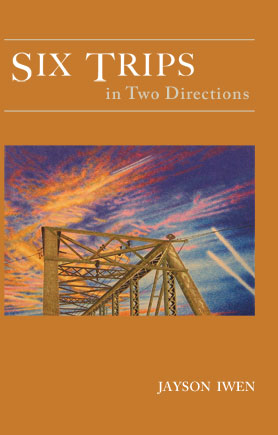| Jayson Iwen | |
|
Six Trips in Two Directions A note on the zajal form used throughout the book.
|
 |
The short poems could be called English zajals. "Zajal" is the family name for the various genera of structurally similar Arabic folk song traditions which are usually performed extemporaneously by poets in public competitions, in which the audience often participates by chanting the refrains. The prototypical zajal is believed to have originated among Arabs living in Andalusia in the 12th century, due, in part, to the influence of popular Spanish folk songs. The first poet to work extensively in the form was Abu Bakr bin Quzman, who lived in Cordoba, Spain, from the late 12th century to the early 13th.
Nowadays, zajals are usually accompanied by one of two types of music,
one being of the nazm tradition, characterized by a regular, trochaic
rhythm, and the other being of the nathr tradition, characterized by a
more flexible, open rhythm. The nazm rhythm usually accompanies zajals
of a more comical, festive nature, while the nathr rhythm usually accompanies
those performed at more formal occasions.
I have liberally adapted my zajals from a species of Lebanese zajal know
as mukhammas mardud. This particular zajal has a more rigid structure,
involving complex relations of rhyme within, and between, each hemistich,
as well as a rhythm similar to that of the nazm style. These zajals also
often involve a ritual enumeration of objects not unlike certain folksongs
in the Western tradition, such as "The Twelve Days of Christmas,"
and, in oral competitions, are often inserted between longer nathr compositions.
"While its rhyming phrases, along with the repetition and reversal
of word order allow for audience participation, its simple but ornate
musical rendition facilitates this participation and establishes a psychological
space, a relief from the heated verbal arguments preceding and succeeding
it." 1
I attempted to maintain the complexity of this Arabic form, while adjusting
it to the possibilities of modern English. For example, I loosened up
the rhyme and rhythm, which would be stiflingly prohibitive in English,
so the hemistichs usually contain three to four beats, but occasionally
fewer or more, and the rhyme, usually a slant, or an "echo,"
zig-zags across the caesura, down the page, until it gets to the last
pair of hemistichs, which echo horizontally, finally leaving the poem
in an aurally and semantically unaligned tail.
Likewise, I recognized, in this form, a way to systematically experiment
with my notions of "the new sentence." For example, with many
of my zajals I attempted to constantly shift the semantic direction of
each succeeding hemistich, without altering the grammatical logic of the
statement-in-progress, while also attempting to grammatically link each
hemistich to the one directly above and below it, making it possible to
read both the right and left columns as separate poems. In fact, when
I read the poems in public, I usually read each poem thrice - the right
column first, followed by the left column, and finally both together,
merging the independent halves into an independent whole (though this
admittedly works best with the more lyrical zajals). In other words, I
wanted to offer multiple, meaningful readings, while still suggesting
a most-worn path.
Consequently, I noticed that the zajal offered a way to create poems
of both sonnet-like compression and haiku-like openness, while delivering
the same rhetorical complexity of the former. Generally (though this is
not a zajal rule - in fact, it's essentially lifted from the sonnet) the
first two lines present a subject, which the following three contemplate,
and the final two further complicate, or provisionally resolve. The overall
result seems to be a kind of gnarled airiness, which I quite like, when
I manage to pull it off. When I manage to pull it off, the poem actualizes
my desire to create something in the metaphysical vein, in the postmodern
age.
The long poems, or "investigations," which are intermittently interrupted by these mukhammas mardud adaptations, are similar, in pace, to the nathr zajal form. However, as far as I know, this is merely a fortuitous similarity. Aside from a little Debord, Silliman, Vonnegut, Wittgenstein, and Zoschenko, formal aspects of whose styles I found it useful to employ, the primary conscious influence on the structure of these long poems was the Smart-Blake-Whitman long free verse tradition.
Jayson Iwen, author
1 Haydar, Adnan. "Mkhammas Mardud in Lebanese Zajal." Post
Gibran: Anthology of New Arab American Writing. Ed. Khaled Mattawa
and Munir Akash. Syracuse: Syracuse UP, 1999. 426.